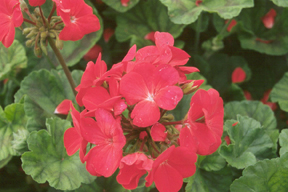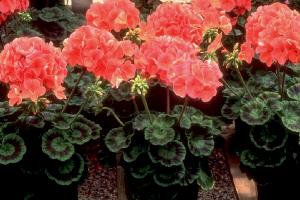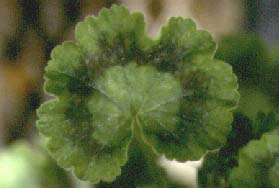|
Plants
for your home
(By Mary Efanti)
Geranium / Pelargonium
Origin - Description
 Most of us consider geraniums to be a “trademark” of Greek landscapes of the Mediterranean in
general. However geraniums originate in South Africa. As our climate offers ideal conditions for this
plant, geraniums rapidly became one of the most characteristic Mediterranean
plants. Most of us consider geraniums to be a “trademark” of Greek landscapes of the Mediterranean in
general. However geraniums originate in South Africa. As our climate offers ideal conditions for this
plant, geraniums rapidly became one of the most characteristic Mediterranean
plants.
But their name is indeed based on the Greek word geranos
(=crane) as their shape reminds of cranes. Geraniums are a big family of plants - the hanging or creeping geraniums
(who have different names) are all part of the same family.
Care
This is one of the
easiest-to-grow plants and it literally thrives on neglect. In the nurseries one can find numerous
cultivars, many of which are created by man, providing different flower
colors, some bicolor varieties, in dwarf or taller forms, or even with fragrant
flowers.
They will thrive in any
soil, even clay, as long as the drainage is good. You should water often but the soil should be allowed time to go dry in between
waterings. When growing in pots, always empty the excess water from the trays to avoid root
rot. You should also avoid spraying the leaves of the plant as they might get dry but you can occasionally give the plant a shower after sunset to remove the dust from the
leaves.
The impressive flowers will start blooming on the first warm
days. Try to remove spent flowers as often as you can in order to encourage development of new
flowers. Blooming will stop when the weather goes cold but the foliage will keep your garden looking full and fresh throughout the
winter.
Geraniums will produce more flowers if they are located in sunny
spots, ideally facing south and they are very hardy to hot weather and
draught. Some of the newest cultivars can be grown in full shade but they will flower less than those varieties that require
sun.
To enhance
blooming, add liquid fertilizer (for blooming plants) every 15 days. You can also use
pellet, slow release fertilizers - in this case you should start fertilizing in the beginning of
spring, when the weather starts to warm up.
You can plant or transplant geraniums at any time throughout the
year, but it would be advisable to do so in spring or autumn so that your plant will have time to get settled in its new environment before extreme weather conditions set in
(heatwaves or freezing).
When you buy
geraniums, prefer plants of lower height and rich foliage. Also, prefer buying plants with more buds than open
flowers.
Propagation
 Propagation
is done easily through cuttings. So, if you notice a beautiful geranium
in a garden, cut off a small branch to grow yourselves. Select a strong
branch and remove the lower leaves. Let the branch dry for a few hours
and then plant it in a pot. Your new plant should stay out of the hot
afternoon sun for a few days but you should water the plant regularly.
Although it is not necessary, you can use rooting hormone for better
results. In the first few days you will notice leaves going dry and
falling off the plant but don’t get discouraged. Very soon you will
notice new growth. When the new plant seems mature and strong enough,
you can transplant it in a larger pot or in the garden. Propagation
is done easily through cuttings. So, if you notice a beautiful geranium
in a garden, cut off a small branch to grow yourselves. Select a strong
branch and remove the lower leaves. Let the branch dry for a few hours
and then plant it in a pot. Your new plant should stay out of the hot
afternoon sun for a few days but you should water the plant regularly.
Although it is not necessary, you can use rooting hormone for better
results. In the first few days you will notice leaves going dry and
falling off the plant but don’t get discouraged. Very soon you will
notice new growth. When the new plant seems mature and strong enough,
you can transplant it in a larger pot or in the garden.
Disease
 Part
of their charm and ease is that geraniums are extremely hardy to most
pests and disease. Occasionally you may notice aphids, if another plant
of your garden is infested, but this is very rare. Part
of their charm and ease is that geraniums are extremely hardy to most
pests and disease. Occasionally you may notice aphids, if another plant
of your garden is infested, but this is very rare.
Add
color to your garden or your balcony by growing geraniums. They are
ideal for planting in limited space in the garden as well as for pots
and hanging baskets if you select the creeping varieties. If you have
ample space, try planting various cultivars of different colors together
with other lower-height annuals such as marigolds or basil.
Mary Efanti
[email protected]
|
